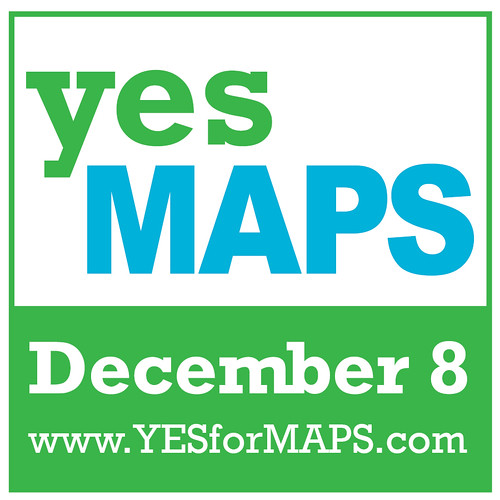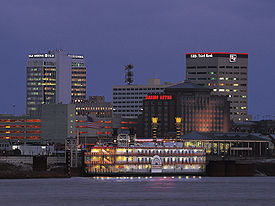 (photo credit: okc.gov/maps)
(photo credit: okc.gov/maps)
Today, the Courier & Press published an article dealing with the high risks Evansville mayors face when they take on large capital improvement projects for the city...
http://www.courierpress.com/news/2011/may/07/no-headline---08a0xelection/
First of all, it is important to understand that not all capital improvement projects are the same. Opening up traffic on Main Street was a horrible idea (the only bad idea on Mayor Lloyd's 2001 master plan), and the Wesselman ball fields would have destroyed one of our greatest capital improvement projects ever built, Roberts Stadium.
On the other hand, Mayor Lloyd's ballpark was a fantastic idea. The only problem I had with it was that it wasn't on the Mulzer Stone lot where baseballs would fly into the river and into the hands of those with kayaks and canoes which is done at AT&T Park in San Francisco and PNC Park in Pittsburgh. Mayor Lloyd's 2001 master plan also called for re digging the old Wabash & Erie Canal, opening up the civic center, building a marina, revitalizing Main Street, and redeveloping the land around Pigeon Creek. All of those ideas are EXCELLENT ideas and, in my opinion, MUST be in any master plan this city decides to implement.
The projects I just mentioned as well as a few other ideas that Evansville has replicated (such as the new arena) have been successful in other cities . Let's take a look...
Louisville, KY
- Closed off 4th Street to traffic and built 4th Street Live
- Built the KFC YUM! Center (and saved Freedom Hall)
- Built Louisville Slugger Field
- Revitalized Old Louisville
- In the process of converting the Big Four Bridge to a pedestrian bridge
Omaha, NE
- Constructed a canal north of Farnam Street in the heart of downtown Omaha
- Revitalized Omaha's Old Market into a shopping destination
- Constructed TD Ameritrade Park
- Constructed the Qwest Center (and saved the Omaha Civic Auditorium)
- Constructed the Bob Kerrey Pedestrian Bridge
- Constructed a Lewis & Clark Trail Center which is run by the National Parks Department
- Built the Lauritzen Botanical Gardens
- In the process of expanding the Omaha Zoo
Indianapolis, IN
- Constructed Conseco Fieldhouse
- Constructed Lucas Oil Stadium
- Built the Central Canal District
- Built Monument Circle
Oklahoma City (under the MAPS program)
- renovations to the Civic Center Music Hall, The Myriad (Now Cox Convention Center) and Oklahoma State Fairgrounds;
-construction of the AT&T Bricktown Ballpark
-construction of the Ford Center, an indoor multipurpose sports arena.
-construction of the "Bricktown Canal"
-construction of a riverfront and recreational dams for the North Canadian River
-the Ronald J. Norick Downtown Library, a four-story main library to replace a facility that had been built in 1951
-a new Library/Learning Center
-development of the Oklahoma Spirit Trolleys, a trolley-replica bus network
(the following are in the process of being built under MAPS 3)
$280 million new 200,000 sq ft (19,000 m2) Convention Center.
$130 million 70-acre (280,000 m2) downtown park similar to Houston's Discovery Green to be located south of current I-40.
$130 million for mass transit including a downtown 5-6 mile modern streetcar system.
$50 million for health and wellness aquatic centers to be located throughout the city.
$60 million for improvements at the Oklahoma State Fair.
$60 million for improvements to the Oklahoma River.
$40 million to extend trails throughout the city.
$10 million to build sidewalks around the city.
What Can We Do To Change The Local Mindset?
In an earlier post, I talked about the MAPS program that Oklahoma City implemented...
http://evansvillemovingforward.blogspot.com/2010/01/how-should-evansville-finance-these.html
http://en.wikipedia.org/wiki/Metropolitan_Area_Projects
Now cities such as Pittsburgh and Jacksonville have begun replicating OKC's plan...
http://www.metrojacksonville.com/article/2009-dec-moving-forward-oklahoma-city
Basically, MAPS works like this...
1. The citizens come up with their own ideas and plans. They then can go around town lobbying for other citizens to support their ideas.
2. The citizens then go to their local government's website and submit the ideas.
3. The ideas with the most votes get implemented (OKC took as many ideas as they could afford).
4. The final ideas are lumped into a program (MAPS).
5. The program is put on the ballot where voters vote to temporarily increase the local sales tax by 1% for 7 years. After 7 years, the tax expires and can only be extended with another referendum.
6. If approved, the 7 year 1% sales tax goes into effect and a committee to oversee the projects is assembled.
7. After 7 years, if there is enough revenue collected, the projects can begin breaking ground. If there is not enough revenue, a temporary 2 year 1% sales tax increase can be voted on, some projects can be scaled down, or some projects can be eliminated completely.
8. Repeat cycle
So far, there have been three MAPS programs and all three have passed voter approval. Not only has MAPS been successful, but it has been successful in Oklahoma, which is the heart of deep conservative country just like Evansville. If they can do it there, we can do it here.
Here are my top 10 reasons why MAPS would be a better success than the current plan...
1. The projects wouldn't be piece mealed. We'd have to get voter support only once to get at least 5-7 projects going. Currently, every project we do is a battle to the bitter end.
2. If MAPS is voted down, the voters can only point the finger at themselves given that MAPS is their own ideas not city hall's.
3. MAPS would gather ideas from everyone not just a select few. With the ball fields project, only one man and his group were ever heard from despite the fact that the majority of residents did not want the project. We were forced to wait until the project died a natural death after many, many, many dollars were wasted.
4. MAPS would give Evansville momentum. With 5-7 projects being constructed at the same time, many young professionals and residents would clearly be able to see the progress we would be making. Evansville would have a "great renaissance" image.
5. Voters couldn't complain that any project wasn't liked. If Evansville didn't like the projects, they would have the chance to vote against them on the website and then vote them down at the polls.
6. MAPS would give our master plan a source of funding. The problem we had with the 2001 master plan was lack of funding. In order to build the 2001 plan, we would have to go to all ends of the earth to find funding. With MAPS it is simple, a temporary 1% sales tax.
7. MAPS would inspire debate. When we did the 2001 master plan, we brought EVERYONE together. We listened to our Chamber of Commerce, city hall, our development agencies, and, most importantly, we listened to the people. For that reason, we inspired debate about everything currently in downtown. We debated the future of the Aztar area, Main St., First Avenue, and everywhere else at the same time. Currently, only one area is ever debated (such as the new arena spot).
8. MAPS will save money. If we do our projects in bunches, we can get bulk discounts on construction work and architectural design. Currently, we do a project and then use more money to renovate it if we decide to add another project to it later. look at the arena/hotel situation. Why not build them together as one building?
9. MAPS will not bankrupt our town. After 7 years of the 1% sales tax, we build what we can with the money we get or do a temporary extension. We would not be taking out a 30-year loan to build a project that may or may not succeed. This would also save us a TREMENDOUS amount of money by avoiding interest rates. Furthermore, while MAPS is being collected during the 7-year tax, it is generating revenue. OKC generated $52 million from interest. Basically, they got a FREE ballpark built.
10. MAPS is personal. Like I said earlier, you and I can come up with an idea and then go around gathering up people's votes ourselves. Instead of having to latch onto another person's project, we can control our destiny. For instance, if I supported building a ballpark, I would go around telling everyone I know to go onto the cities website and write-in "ballpark." If I really wanted the idea to get passed, I could do ads, post signs, and knock on doors. MAPS makes capital improvement projects personal for every single resident.
Unfortunately, there is one obstacle we would have to overcome to get a MAPS program here in Evansville. Currently, Oklahoma is a referendum state and Indiana is not (like almost every other eastern state minus Ohio). This means that we could not put together a MAPS plan and then have a binding vote at the polls on it. To get around this law, I have compiled a few ideas...
- Lobby your state legislators to change the law
- Have a non-binding vote where we would adopt the Yes or No majority vote but it wouldn't be binding
- Skip the vote ONLY if we are confident that the majority of local residents came to the website to give us their idea
- Lobby for a special exemption to the law
- Use local funding instead (ex. Aztar, food and beverage, etc) that could get around the state law
I am very disappointed that Mayors Roberts, Lloyd, and Weinzapfel have taken a significant amount of heat for building or trying to build Roberts Stadium, a new ballpark, and the new downtown arena respectively, although I will be disappointed if Mayor Weinzapfel demolishes Roberts Stadium.
We absolutely have to undertake large capital improvement projects, and I hope you will join me in the effort to bring MAPS to Evansville!
 (photo credit: flickr/caseycornett)
(photo credit: flickr/caseycornett)






No comments:
Post a Comment